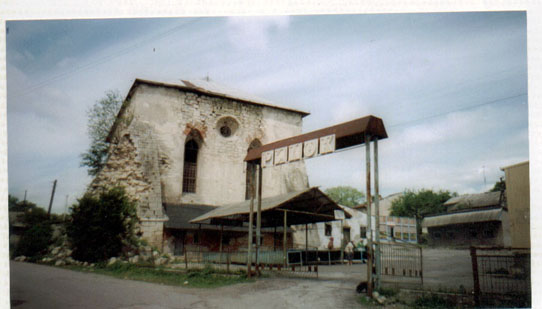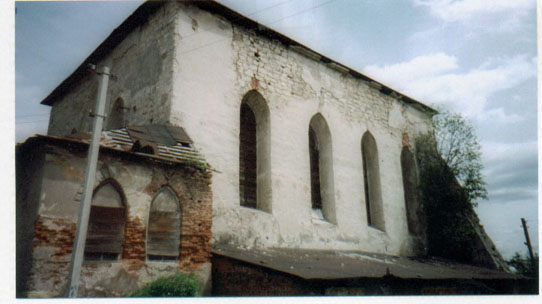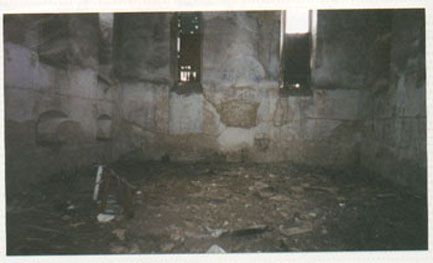PODHAJCE,
UKRAINE
(PODGAYTSAY)
On
May 22, 2001, my husband and I made a trip to Podhajce, the shtetl from
which my maternal grandparents came and about which I had heard so many
times when I was a child. We were in Lviv on an Elderhostel trip
to
Ukraine and Russia. Prior to leaving the U.S. we had arranged for
a
driver and guide to accompany us on this one-day journey. Our
guide,
Svetlana, arrived at the agreed upon 8 a.m. departure time, and we were
off. Podhajce was only 75 miles from Lviv, but the poor
road
conditions made for a slow ride.
Typical
sights along the way included cows being herded along the side of the
road. Our guide explained that the owners take the cows out each
day
to graze along the road-side. The fields are all planted, so no
grazing can be done there. Another common sight were horses
pulling
wagons. The wagons were sturdy and made of wood in various sizes
and
designs.
Svetlana
said that Podhajce translates roughly into "town under the
woods."
Other towns or villages through which we passed were translated as
"wild trees", "under the big rock stream" (located on "the rotten lime
tree river"), "dawn", and "peaceful".
Our
guide related the following information as we drove along.
Podhajce
was founded in the 13th century. The first Jews came in the 15th
century. Country fairs were often held; in 1519, there were
a number
of fairs, and these helped the growth of the Jewish
merchants. In
1820 alone, there were 11 fairs. The Jews lived in the southern
part
of Podhajce. Before WWI, there were 3,700 Jews living in
Podhajce, and
there were 4 Jewish schools. In 1921, 60% of the population was
Jewish. The population of Podhajce is now 3,000, and there are no
Jews, since all but a few were murdered in the Holocaust.
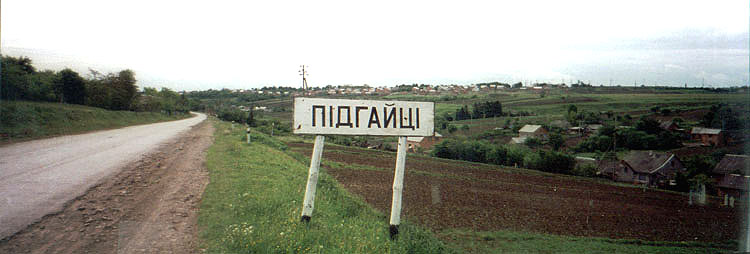 A LESS
ELABORATE SIGN WITH A VIEW OF PODHAJCE
A LESS
ELABORATE SIGN WITH A VIEW OF PODHAJCE
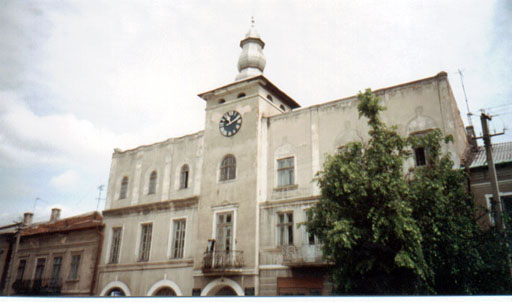
THE
OLD CITY HALL
SOME
OF MY FAMILY'S HOMES AROUND THE SQUARE
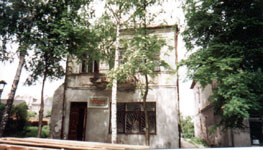
KIMEL
HOME
|
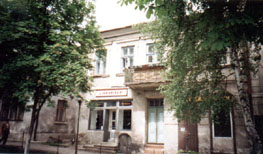
MICHAEL
LEHRER HOME
|
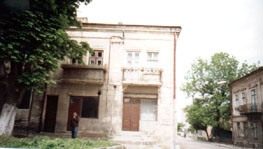
MORDECHAI
LEHRER HOME
|
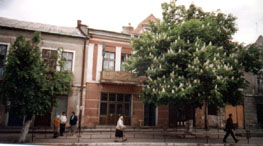
MILCH
HOME
|
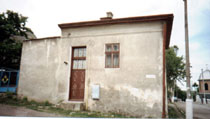
BARON
HIRSCH HOME
|
OTHER BUILDINGS IN PODHAJCE
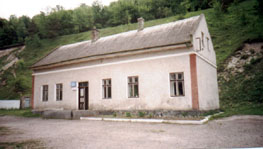
Fischer
Home - later a vetrinary clinic
|
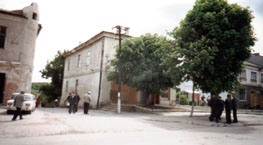
Home of
Dr. Sher (dentist)
|
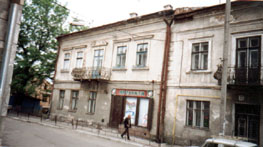
Home of
Dr. Kessler
Right: An indentation shows where
a Mezzuzah used to be --->>
|
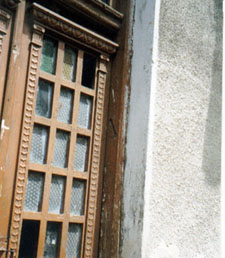
|
As
we were wandering on a side street, a gentleman came along and struck
up a conversation. He was Dr. Bohdan Metyk, a retired physician with a
very good command of the English language.. It was "beshairt" that we
should meet him. He identified some of the homes shown above, and then
went with us to the synagogue. Now in ruins, the synagogue was erected
in the first half of the 17th century. ( The number 1559 on the
synagogue plaque is not the date of dedication.)

The
synagogue itself was obviously once a large and imposing structure.
Today, it is only a shell. On the side is a small open-air market. I am
torn between saying it should be restored or saying leave it as a
symbol of the lives that were destroyed in Podhajce.
With
Dr. Metyk leading the way, we walked the few blocks from the synagogue
to the cemetery. It is in a large, partially fenced-in
field. A horse
who wandered up to us was an indication that the cemetery is used
for
grazing. There were hundreds of large grave stones on either side
of
the field. The middle portion was clear, as these stones had been
removed and used for things such as paving blocks. Identifying
individual stones would be a monumental task.
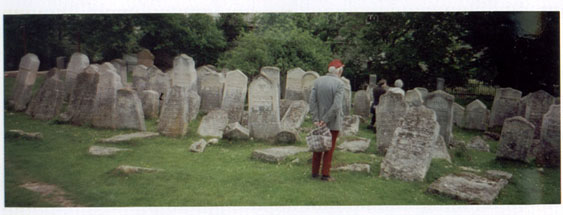 |
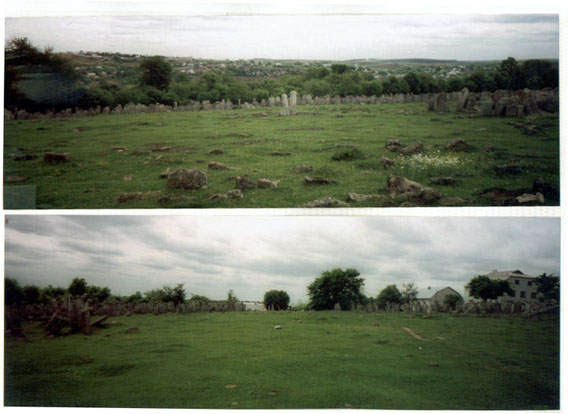
|
Dr.
Metyk said that he knew of a mass burial ground just outside of the
city and asked if we would like to see it. He made a phone call
to get
directions and went with us in the car. Twice, we stopped to ask
people for more specific directons. (Obviously, the existence of
the
grave was of common knowledge.) We came to a hill, at the top of
which
the grave was said to be. There was not a road leading to the
top,
only two ruts that indicated a path used by horse and wagon.
However,
our driver was determined to get us up there, and he did. There
were
two markers--one an old gravestone from the cemetery and the other a
metal stele. On the latter, the Hebrew reads:
This place is a mass grave of the martyrs that were
killed for
the sanctity of God by the Nazis, may their
name be forever blotted out.
God shall revenge their blood.
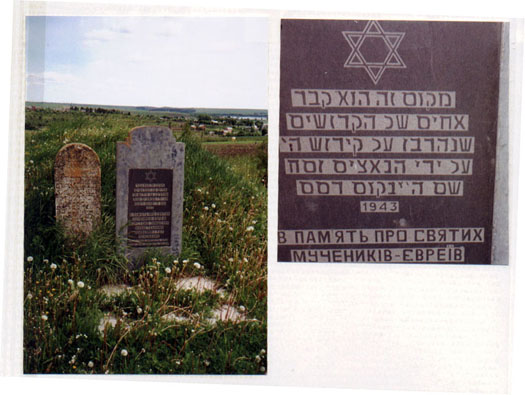 The
grave mound is still very visible. It is the final resting place of
some 800 Jewish residents of Podhajce. To think that such horror could
have occurred in such an idyllic setting.
The
grave mound is still very visible. It is the final resting place of
some 800 Jewish residents of Podhajce. To think that such horror could
have occurred in such an idyllic setting.
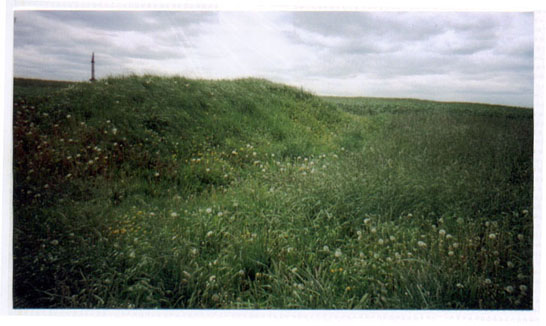
JEAN
ROSENBAUM
HOUSTON,
TEXAS
email:
mervinr@hal-pc.org














